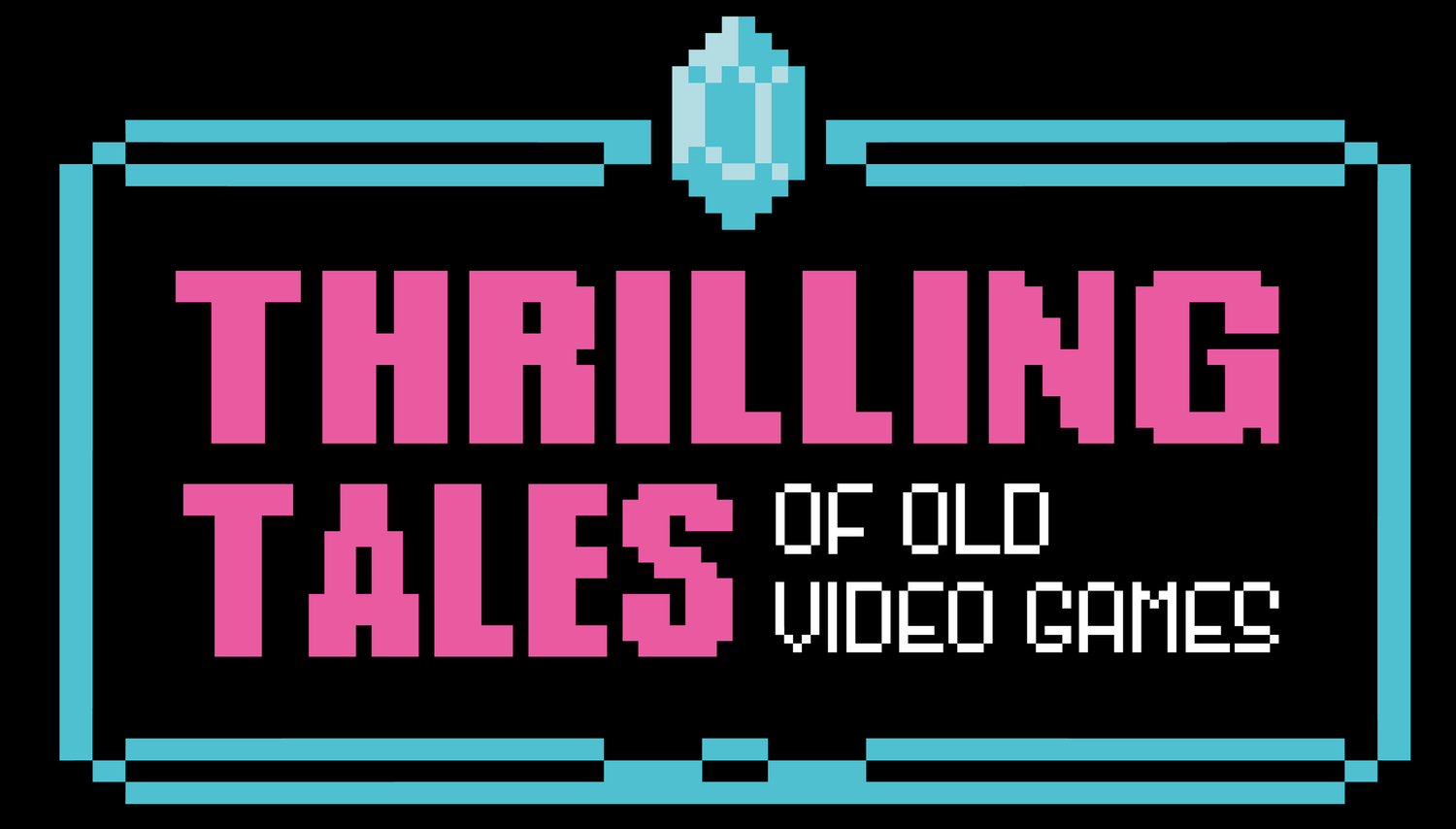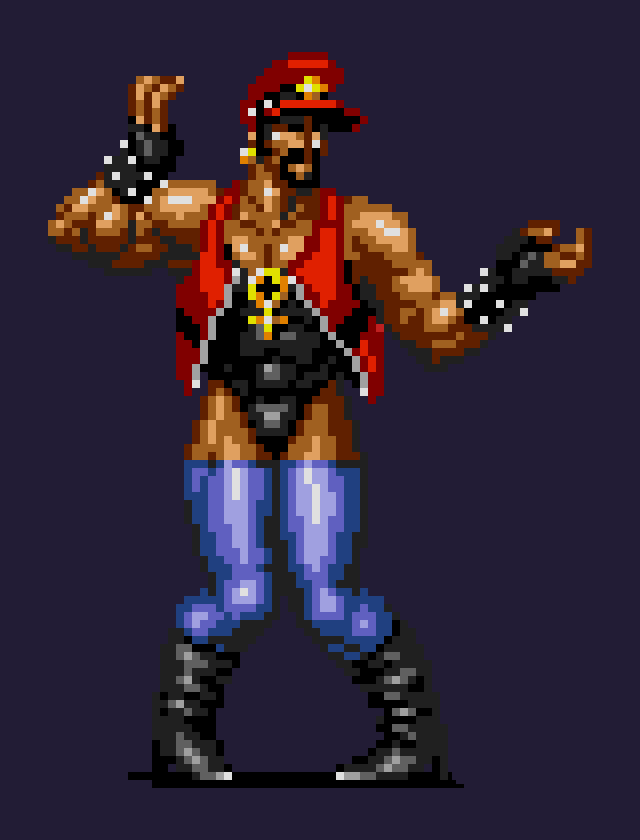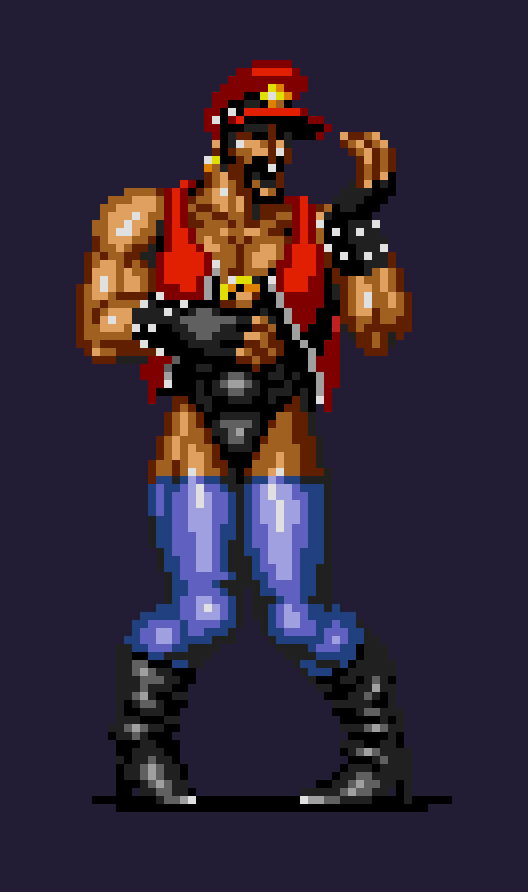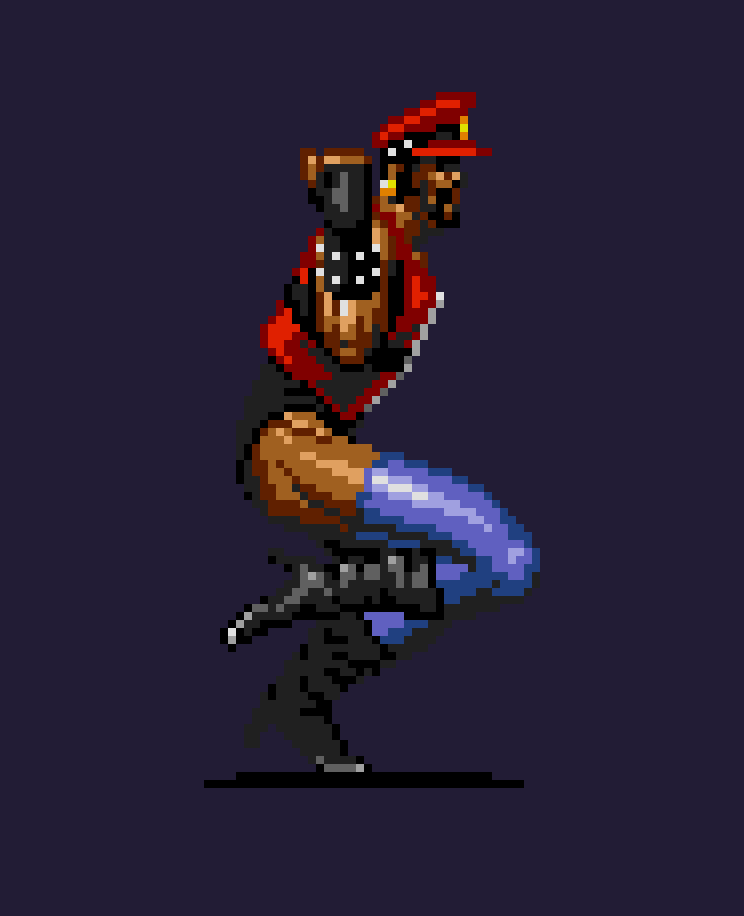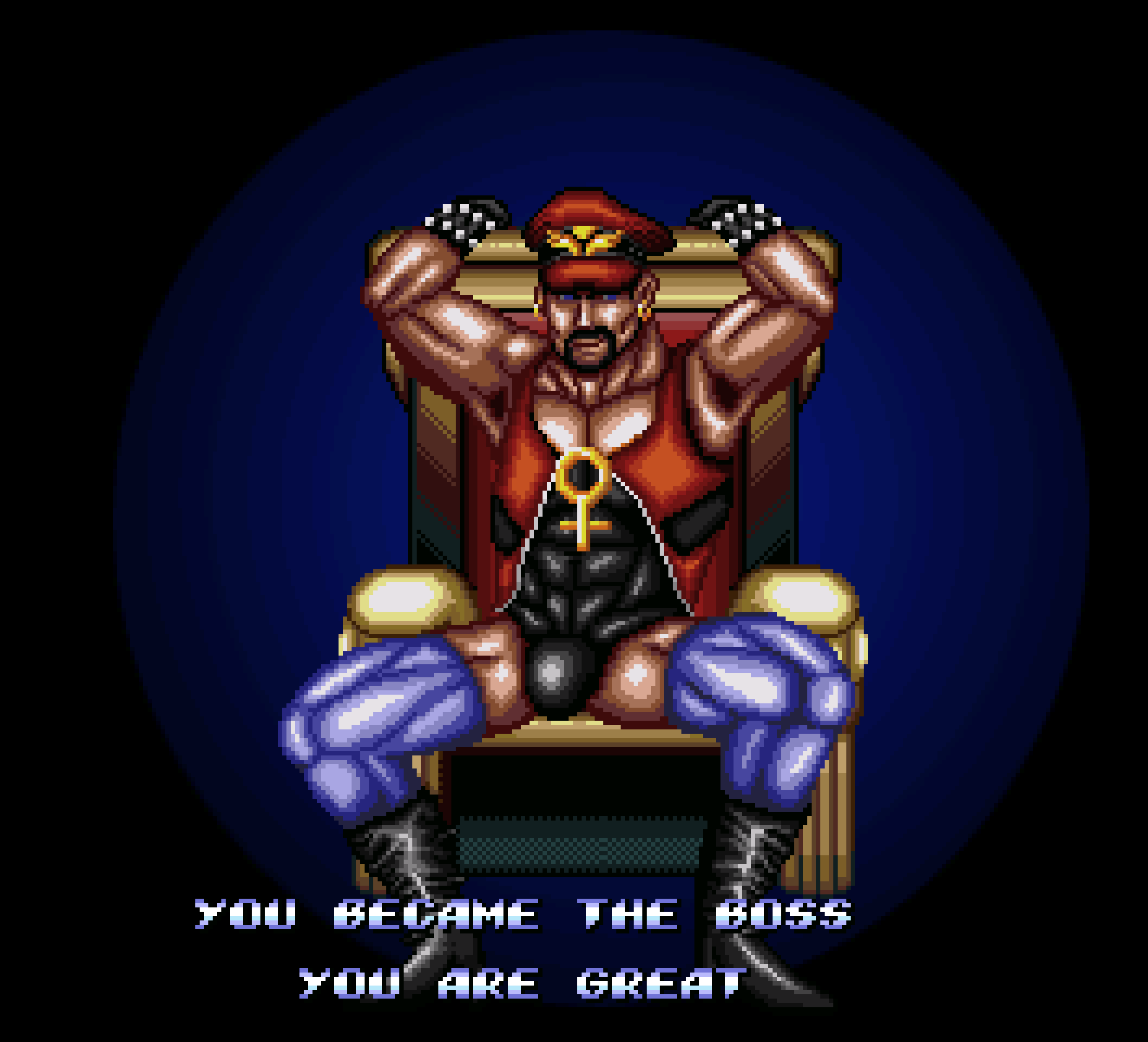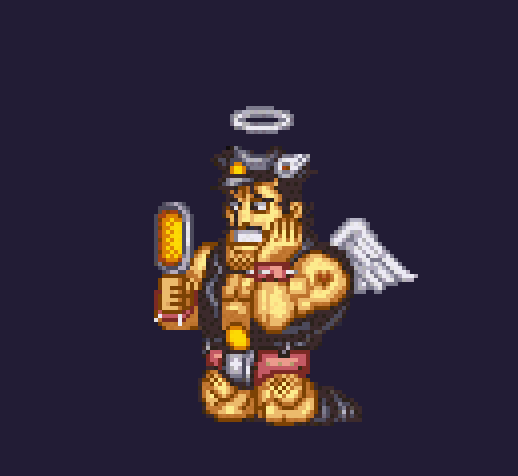Streets of Rage’s Ash Never Got His Moment in the Spotlight
Fair warning: This may be the only text in the history of humanity to discuss Streets of Rage in the context of Designing Women.
When Streets of Rage 4 debuted in 2020, twenty-six years after the release of Streets of Rage 3, the developers stacked the roster to capitalize on gamers’ nostalgia for the long-dormant series. Almost every character from every previous game comes back, retro sprites and all, and what’s more, you get multiple versions of many of them. There are fully four different versions of series leads Axel or Blaze as a result.
The list of available characters even includes Streets of Rage 3’s Roo, a boxing kangaroo and also a secret character unlockable under certain conditions. And while Roo’s inclusion does make Streets of Rage 4 seem comprehensive, there is one character who didn’t make the cut: Ash, a boss who was also a secret, unlockable playable character in the Japanese version of the Streets of Rage 3. He’s nowhere to be found in the overseas localizations — and only playable in the North American version via a Game Genie code.
Ash is a rather expressive individual, you see.
I will point out that in the time when Mai Shiranui’s bosom bounce was a much-discussed phenomenon, Ash’s bulge was animated with a little jiggle. (Via LGBTQ Video Game Archive.)
I’m unsure what to call Ash’s leg coverings. Are they… tights? socks? Some form of fetish legwear I’m just not familiar with? (Via LGBTQ Video Game Archive.)
Can you hazard a guess why Sega would have declined to include Ash in the English localization of Streets of Rage 3? If you’re not sure, watch him in action as a boss.
Of course, this fight only exists in the original, Japanese version of the game. In all other versions, the boss fought in this shipyard area isn’t Ash but instead Shiva, a recurring character and the right-hand man to the series big bad, Mr. X. Shiva also happens to be a lot more masculine-presenting than Ash, and I don’t think that’s a coincidence.
Although Sega has never stated the reason for removing Ash from overseas localizations of Streets of Rage 3, I presume this act of self-censorship resulted from the optics of having the game’s heroes beat up what amounts to a flouncy gay stereotype. After all, Ash’s combat tactics include giggling, leaping across the screen ballet-style and running around in a way that recalls Jackée’s character from 227. Should LGBTQ-focused media watchdogs have objected, they would have a fairly easy argument that the game was endorsing homophobic violence. But then again, such a character being included in the game at all, even if he exists just to be beaten up, might have also angered western conservatives who wouldn’t want any gay representation in media advertised to children. Thus, by the standards of 1994, I suppose it’s not surprising that Ash got the axe.
Writing this in 2025, however, I say it’s too bad that Ash didn’t get to make a comeback in Streets of Rage 4. Although people in general and people in the U.S. especially are always going to be touchy about the depiction of LGBTQ characters, there’s something to be said for including an effeminate gay man in a street crime organization because it literally makes him one of the gang, his sissy behavior notwithstanding. Like, it’s kind of progressive that Mr. X was willing to employ Ash at all, the implication being that he may be the kingpin to an evil crime organization, but he’s no homophobe. It occurred to me while I was writing my post on Street Fighter’s first gay character that Eagle is a little milquetoast, especially in the English localization, which minimizes some of the cattiness and horniness that comes through in the game’s original Japanese dialogue. Ash, a camp weirdo dressed in fetish gear is in many ways the opposite of Eagle. Add on top that he gets to be a bad guy, and he ends up a lot more interesting of a character, at least in my book.
In case you don’t know, I host a podcast about LGBTQ episodes of old sitcoms called Gayest Episode Ever, and early in the run of our show, my co-host and I stumbled onto a trend that began during the AIDS crisis and persisted through the 2000s. We call it the “angel gay.” The prime example of this is a character appearing in the 1987 Designing Women episode “Killing All the Right People,” Considering the national attitude toward this disease and the gay men dying from it in great numbers, series creator Linda Bloodworth-Thomason decided to make the episode’s focus character — Kendall, who’s dying of AIDS — as appealing as possible to viewers who might be predisposed to reject such a character.
Kendall is polite, well-dressed and handsome. He doesn’t read as gay, except for the fact that those three adjectives I just listed can, when appearing in conjunction, be code for gay, and there’s not the slightest whiff of sexual agency to him at all. Basically, Kendall is a homosexual minus the sexual. Today, this episode of TV is considered to be a milestone in the effort to produce media that would make Americans think more favorably about gays and people with AIDS, so I suppose that the gambit worked. But a weird result of this episode’s success is that LGBTQ characters in general and gay male ones in particular ended up being a little bland, because they were being written for straight audiences that had to be convinced not to dislike them. Like poor doomed Kendall, they all had to be upstanding citizens who didn’t talk about their own sex lives, to say nothing of the idea of letting them get any action onscreen. Although it’s less the case today, the legacy of the angel gay era is a hesitation to let LGBTQ characters be as bawdy, as selfish or as messy as their straight counterparts — and before you bring up Jack from Will & Grace, I will point out that Jack only exists to counter the fact that Will is so staggeringly boring.
In some ways, the version of Eagle that appears in Capcom vs. SNK 2 and Street Fighter Alpha 3 Upper works similarly to these TV characters who have had all their rough edges sanded off. Eagle is polished, clean cut, and no exaggeration, one of his defining character traits is being respectful. Ash, on the other hand, is rocking a mankini, leather gear including that cap you see leather daddy types wearing, and a prominent Venus symbol medallion, which just further complicates the frothy mix of masculine and feminine he’s putting out there. He’s kind of a mess, in that I’m not sure what subcultures he’s supposed to be claiming with this outfit, but he’s an interesting mess — and for what it’s worth, Sega’s official art of him makes look pretty damn sexy despite the fact that in the game itself he amounts to a joke.
Just looking at this art, you wouldn’t necessarily guess that Ash’s function in the game is as an effeminate joke. He’s dressed exactly the same, but he’s posed (and built) like a Tom of Finland character.
Because he’s a first-level boss in the game and a fairly non-challenging one at that, I do believe the creators put him in the game for players to laugh at. On its own, that’s not great, but in creating this villainous effeminate character, they also made something that bucks a different stereotype of gay men being well-mannered boy scouts who recycle and vote and don’t display an iota of sexuality out in public. And while Ash might not have made sense to include in the western release back in 1994, I feel like he should have made the cut for Streets of Rage 4, especially if he were only a playable character and not a boss. He’d just come off like an effeminate hero — floating around every stage like Tinkerbell, sure, but also just as capable of beating up the bad guys.
As it stands, the game’s only mention of Ash in Streets of Rage 4 is as a poster hanging in the room where the player fights the third level boss, Nora.
A generic enemy in the first game, Nora is your standard whip-wielding female beat-’em-up baddie dressed like a dominatrix. And while she looks very similar in Streets of Rage 4, it’s this version that reminds me of a genderflipped version of Ash. At the very least, it seems like Ash and Nora shop at the same boutique, no?
By 2020, the U.S. had gotten a decent number of kids’ shows with queer characters, including Adventure Time, Steven Universe, The Legend of Korra, The Owl House and the She-Ra reboot. Although there will apparently always be people who complain about that kind of thing, I feel like it was common enough that a game like Streets of Rage 4 could have tossed Ash in and it would have been okay. It might still have incurred the wrath of watchdog groups, but even then progress with the portrayal of gay characters had gotten to the point where some LGBTQ fans of Streets of Rage would have championed his inclusion. I know I would have.
Again, it’s nice to be included as one of the gang, even if that gang is an actual criminal syndicate.
Miscellaneous Notes
In researching why Ash did not appear in any versions of the game outside the Japanese release, I did see a few people point out that as a playable character he has an incomplete moveset. I don’t think this was Sega’s motivation for pulling him from the international releases, however, because that wouldn’t have affected him being the first-level boss. No, unless someone can show me an interview proving otherwise, I’m fairly certain it stemmed from Sega being uncomfortable having a gay character in the game at all, much less one who gets slapped around.
If asked to explain why Ash exists at all and why any video game from this era would include an effeminate but physically formidable guy in fetish gear, I would guess it had something to do with Hard Gay, a comedy persona performed by comedian/pro wrestler Masaki Sumitani.
But here’s the thing: Hard Gay didn’t debut until 2002, so Ash preceded him by several years. Ash isn’t even the first gay leather man in video games. The 1991 Konami beat-’em-up Vendetta, for example, features a pair of them who will actually hump your male character as a form of attack.
There’s also the image of a… gay leather man angel? It comes from the 1995 Super Famicom title Go! Go! Ackman 3, which I know is based on an Akira Toriyama manga, but I don’t know much about this character other than he looks like several gay stereotypes rolled into one.
Although it’s possible all these games are riffing on a single pop culture antecedent, I feel like it’s more likely that they’re instead products of Japanese fascination with a particular gay subculture. (Again, correct me if I’m wrong.) Even the name Hard Gay hearkens back to an interesting Japanese term, ハードゲイ or hādogei, referring to a host of queer subcultures including leather, punk, BDSM, bodybuilding and others with hypermasculine associations. According to Japanese Wikipedia, the term passed into more popular usage during the promotion of the 1980 film Cruising, in which Japanese marketers apparently needed to differentiate that film’s depiction of New York City gays from so-called more effeminate gay men or “soft gay” (ソフトゲイ or sofutogei).
This Japanese conception of allegedly masc gays reminds me of a running joke through the first few Police Academy movies, which as a boy born in 1982 I watched repeatedly. A gay leather nightclub called The Blue Oyster Bar recurs throughout the first four movies in that series, and in each one, it’s more or less offered up as a chance to laugh at men who are into men — and who, if given the opportunity, will jump on straight men and force them into their gay shenanigans. Rewatching these scenes all these years later, I was surprised to find that they’re not as bad as I might have imagined.
Honestly, I can’t even begin to imagine how stuff like this shaded my perception of gay men or even made me doubt whether I could be gay, but that’s a conversation for my therapist.
As a playable character, Ash wears a red and blue outfit, but as a boss character, he wears purple and greens. What’s interesting about this color combination is that it’s frequently one that American superhero comics uses to denote evil, and you see them paired together on many iconic bad guys: The Joker, Lex Luthor, Green Goblin, the old-school version of Catwoman, Mysterio, Braniac, The Lizard, The Riddler, the Marvel version of Morgan Le Fay, the DC version of Circe, Mesmero, Kang the Conqueror, and some older depictions of Two-Face. I’m not sure when it became a meme that comics creators were aware of, but it most likely stemmed from needing to contrast against the primary colors that comprised most superheroes. The only exception I can think of is The Incredible Hulk and his iconic purple pants, but even then it’s complicated because the Hulk often has an element of danger to him that other superheroes do not.
The setting of the Streets of Rage games, it seems, is the improbably named Wood Oak City, which is truly one of those names that technically is English in terms of the words used but also would never be the name of a locality named by an English-speaker. It manages to out-Japanese the settings for other similar series, such as the redundant Metro City in Final Fight and the rather nondescript Southtown in Fatal Fury and Art of Fighting.
All of this talk of video games and gay subcultures makes me recall one of the more interesting indie games to carry this torch, Strange Flesh. Have a look. You’ll be able to tell fairly quickly whether it’s your thing or not.
Back when I did a post exploring how the Street Fighter/Final Fight character Sodom ended up with that name, I noted that there would seem to be something gay and illicit happening in the background of Birdie’s stage in Street Fighter Alpha 2. Specifically the guy opening the stall door looks a lot like Ash.
At the time I wondered if it was a reference to him, but now I think they’re both riffs on the same thing — but again, I’m unsure whether it would be a specific antecedent or just a general Japanese fascination with hādogei culture. Thoughts?
Regarding Gayest Episode Ever, my short list of a characters who don’t fit the angel gay stereotype includes Max from Happy Endings, Titus from Unbreakable Kimmy Schmidt, Dean Pelton from Community, and David from Schitt’s Creek, even if he ends up marrying a newly out gay who’s so new to the community that he’s basically straight. In fact, our recent Schitt’s Creek episode is all about how I love David as a character even if I don’t love what the show does with him once his end goal love interest shows up.
